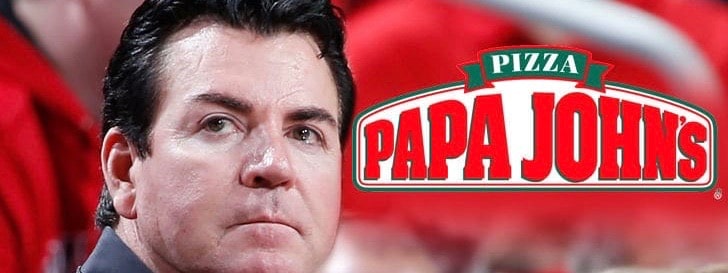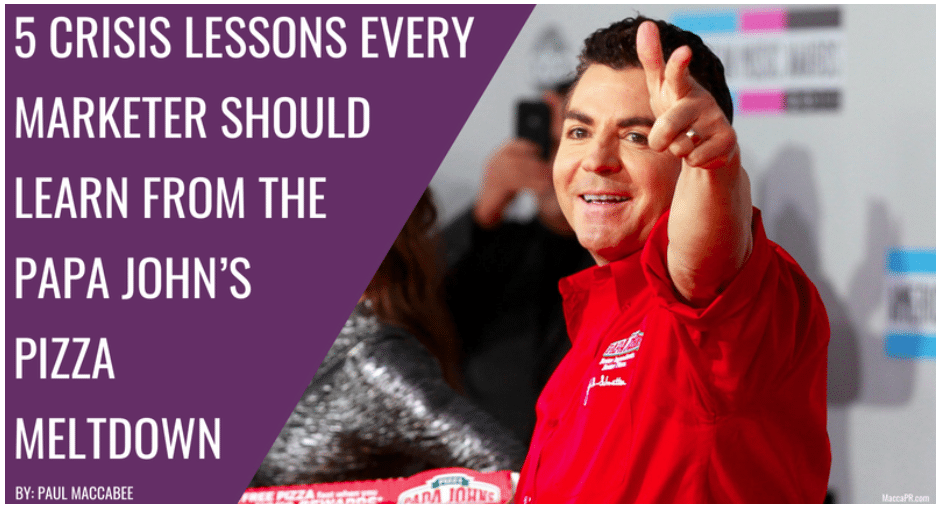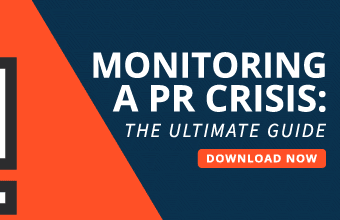As corporate crisis aficionados know, the reputational collapse of the 3rd largest pizza delivery chain in the world reached its tipping point when founder and CEO John Schnatter, the personification of $1.7 billion Papa John’s – a company whose logo featured Schnatter’s face, rather than a mouth-watering pizza, as its core brand image – used an ugly racial slur during a training call with its agency Laundry Service last May.
The fallout when Schnatter’s off–the–rails racial rant leaked out on July 11 was rapid and relentless. Media agency Initiative, advertising agency Fallon, creative agency Laundry Service and PR firm Olson Engage all resigned Papa John’s, an extraordinary situation in our marketing world. Forbes’ blistering expose, “The Inside Story of Papa John’s Toxic Culture,” outed the CEO for activities ranging from “spying on his workers to sexually inappropriate conduct,” and worse. Schnatter resigned as Chairman on July 11. Then, four days later, the pizza chain’s Board of Directors terminated Schnatter’s Founder’s Agreement, which defined his role “as advertising and brand spokesperson for the company.”
As a result, Schnatter’s face was pulled from all Papa John’s signage and other marketing materials. Forbes now reports that Papa John’s shares have dropped 19 percent, “wiping out about $100 million of Schnatter’s fortune.” The brand’s name is now being removed from football stadiums, including from the field house in Schnatter’s hometown of Jeffersonville, Indiana.
So what can public relations and marketing pros like you learn from the Schnatter debacle? We asked three national crisis experts – Kathy Tunheim, Paul Omodt and Jon Austin – to join us in picking through the smoking carnage at Papa John’s and share their advice:
#1 – Nothing Your CEO Does Is Safe From the Public Eye – Nothing. Is. Private.
Most CEOs in the public eye have undergone media relations training, preparing for those few minutes that they’re on camera or face-to-face with a reporter. The Papa John’s incident proves that when the red light blinks off at CNBC-TV or the Wall Street Journal reporter closes her notebook, your CEO must still speak and act with integrity. What’s more, they must now recognize that anything they say – anywhere at anytime – will be exposed, recorded, broadcast, tweeted, posted and shared on social media.
 What’s unique about John Schnatter’s situation is that it appears he was exposed by the very agencies Papa John’s hired to smooth out his rough edges. “What’s most interesting to me about Papa John’s is how the incident got brought to light in the first place,” says crisis counselor Jon Austin of J. Austin & Associates (featured at left). “As I understand the backstory, Schnatter was doing training on the phone with Papa John’s outside agency, when he uttered his epically stupid, amazingly offensive statement. The agency resigned the account – kudos to them – but it looks to me like someone then outed Schnatter. That seems like something of a gray area. If, for example, a client were to say to me, “I eat people,” I’m guessing most of us would be OK outing that guy. Outing someone for offensive remarks – and breaking the promise of confidentiality and client loyalty you make when you sign up for the account – takes a little more thought. What if the remark had been something related to an ethnic stereotype? Someone’s appearance? How they dress? Where do you draw that line and what goes into that decision?”
What’s unique about John Schnatter’s situation is that it appears he was exposed by the very agencies Papa John’s hired to smooth out his rough edges. “What’s most interesting to me about Papa John’s is how the incident got brought to light in the first place,” says crisis counselor Jon Austin of J. Austin & Associates (featured at left). “As I understand the backstory, Schnatter was doing training on the phone with Papa John’s outside agency, when he uttered his epically stupid, amazingly offensive statement. The agency resigned the account – kudos to them – but it looks to me like someone then outed Schnatter. That seems like something of a gray area. If, for example, a client were to say to me, “I eat people,” I’m guessing most of us would be OK outing that guy. Outing someone for offensive remarks – and breaking the promise of confidentiality and client loyalty you make when you sign up for the account – takes a little more thought. What if the remark had been something related to an ethnic stereotype? Someone’s appearance? How they dress? Where do you draw that line and what goes into that decision?”
 “As an organization, Papa John’s was going through crisis scenario training when John made his comments,” noted crisis advisor Paul Omodt of Omodt & Associates (shown to the right). “But to me, that training seemed ill-conceived – ground rules evidently weren’t effectively set. When doing table top crisis drills, executives must know what they are training for, what their company’s core principles and ground rules are and what topics are part of the drill. The larger point is what I stress with my clients: Crisis reveals character. Crisis reveals how you act when you or your organization feels threatened. Schnatter revealed something of himself during the drill that would have been better off addressing proactively, rather than doubling down on trying to refute or debate it.”
“As an organization, Papa John’s was going through crisis scenario training when John made his comments,” noted crisis advisor Paul Omodt of Omodt & Associates (shown to the right). “But to me, that training seemed ill-conceived – ground rules evidently weren’t effectively set. When doing table top crisis drills, executives must know what they are training for, what their company’s core principles and ground rules are and what topics are part of the drill. The larger point is what I stress with my clients: Crisis reveals character. Crisis reveals how you act when you or your organization feels threatened. Schnatter revealed something of himself during the drill that would have been better off addressing proactively, rather than doubling down on trying to refute or debate it.”
#2 – Many Founders/Spokespeople Are Too Fallibly Human To Be The Essence of Your Brand
Employing a charismatic company founder, celebrity spokesperson or CEO as the sole face of a mega brand – as exemplified by Apple’s Steve Jobs, Ben Cohen and Jerry Greenfield of Ben & Jerry’s, Amazon’s Jeff Bezos and Tesla’s Elon Musk – can humanize and bring a corporate brand to life. But when the flaws in the company’s spokes-founder or spokes-celebrity come to light, such as with Subway spokesperson and now convicted sex offender Jared Fogel, a brand hanging by that single person’s reputation can tank. Even offenses in retrospect can hurt a brand. Can anyone eating Jello today forget that Bill Cosby was that product’s enthusiastic pitchman, years before his recent conviction for sexual assault?
“Invest in a spokesperson at your own peril,” warns Austin. “If you’re going to make John Schnatter or Jared Fogel the face of your company, you own the good, the bad and the ugly that comes with them.”
Schnatter owned about a third of all Papa John’s shares, and reportedly resisted removing his face from advertising. “Founders are dangerous people,” continues Austin. “Whether it’s Schnatter deciding that he doesn’t want to leave or a Twin Cities millionaire deciding he wants to return to run the retail chain he started, founders feel entitled to do what they want, when they want. Smart companies need to spend time thinking about what they’ll do if they find themselves adverse to their patriarch.”
#3 – Board Members Must Be Ready to Choose the Survival of the Brand Over the Ego of Its Top Executive
 “Lots of aspects of the Papa John’s situation warrant review and reflection,” says Kathy Tunheim, Principal and CEO of the agency Tunheim (pictured left). “But, I’ll focus on my most fundamental observation: Boards of directors need to do their job, even when the CEO is the ‘face of the brand.’ When the CEO is also the largest shareholder, the job of the board becomes even more difficult. But if you aren’t going to do it, don’t accept the board of directors role or the compensation that comes with it.”
“Lots of aspects of the Papa John’s situation warrant review and reflection,” says Kathy Tunheim, Principal and CEO of the agency Tunheim (pictured left). “But, I’ll focus on my most fundamental observation: Boards of directors need to do their job, even when the CEO is the ‘face of the brand.’ When the CEO is also the largest shareholder, the job of the board becomes even more difficult. But if you aren’t going to do it, don’t accept the board of directors role or the compensation that comes with it.”
“The reality is, from the time that Schnatter made statements that offended many core customers, the board faced a choice between the company’s interests and those of its largest shareholder,” adds Tunheim. “They took months to make the right choice: they should have protected the interests of the corporation. By the time the board did that in July, they had allowed a fatal deterioration of the company’s health.”
Perhaps the most revealing quote from the 37 former and current Papa John’s employees interviewed by Forbes was: “Papa John’s has effectively been a public company operated like it is privately owned.” Even more appalling for a public company wrestling with a seamy culture that involved jokes about “gangbangs,” Forbes revealed that “corporate employees have signed nondisclosure agreements barring them from discussing Schnatter’s personal life – other confidentiality and non-disparagement contracts and mandatory arbitration agreements further discouraged people from speaking out. So Papa John’s legally gagged its employees, in a company-wide effort to muzzle criticism.
#4 – In This Age of Trump, Carefully Monitor the Direction of Your CEO’s Public Stands
In recent months, we’ve seen CEOs expressing their personal views on same-sex marriage, immigration policies, gun control, racial discrimination and other hot-button issues. Long before Schnatter’s recent N-word crisis exploded at Papa John’s, the pizza chain had been dealing with the fallout from Schnatter’s attack on how the NFL dealt with black athletes’ protests during the national anthem at football games.
“John represents the new concept of corporate CEOs who are taking stands on issues,” adds Omodot, “giving commentary on the NFL anthem debate, which put him more in the spotlight and set him up for a bigger fall when the recent comments came out. My advice to PR professionals is, be clear about what your CEO believes, why he or she believes it, and how it impacts your organization. There’s nothing wrong with a CEO having a point of view – but use it with the knowledge that not everyone is going to agree with you.” (For more advice on how your company can prudently take a political stand, check out our earlier blog post, “When Marketers Dare to Take a Stand“). Does your CEOs personal stand for or against, say, gay marriage, reflect the views of your company as a whole (its employees, its shareholders) and, most importantly, the attitudes of your customers and other stakeholders?
#5 – Make Your Brand About All Of Your People, Not Just One Top Executive
“We’ve seen organizations that are too tied to one person as their brand touch point, and how it can go badly when they fail to represent the brand well,” notes Omodt. “Papa John’s may go into the same realm as Jared from Subway – being the face of the brand while he was hiding an ugly truth. My advice to clients is this: people make your brand. It is the sum of all the touch points you have with the brand. It is ‘people,’ not a single ‘person,’ who should build your brand. Otherwise, brands run the risk that a single person, representing the brand, can bring it down.”

Initially, it appeared that Papa John’s crisis response was to stonewall. Contacted by Forbes about the chain’s culture under CEO Schnatter, the magazine reported: “Papa John’s did not respond to repeated requests for comment.” Once Forbes published its explosive report, Papa John’s shakily responded with an opaque statement, “If anything is found to be wrong, we are determined to take appropriate action.”
To its credit, Papa John’s has now posted an open letter from CEO Steve Ritchie on its home page expressing what appeared to be a sincere apology, insisting, “I know the words of John Schnatter were offensive . . . Racism and insensitive language . . . will not be tolerated at any level of our company. Period.” However, the chain’s crisis pros made the rookie mistake of also expressing the suffering that the CEO was feeling (“. . . nothing pains me more than knowing they hurt you,”) which does not belong in a corporate apology.
Wisely, the company has made it clear that despite the reported $72 million it spent in 2017 on promoting John Schnatter’s face in its advertising and signage, the company is now trying to dislodge Schnatter from its brand, saying, “Papa John’s is not an individual. Papa John’s is a pizza company with 120,000 corporate and franchise team members around the world.” It may take years to assess if pizza-eating consumers will see Papa John’s as anything other than “Papa” John Schnatter’s company – and choose their pizza chain accordingly.
A bold first step that would demonstrate honest contrition by the company? Papa John’s could unilaterally dissolve every one of its employees’ confidentially contracts that had insulated their CEO for years. Instead, the company could encourage those 120,000 employees and franchise members to openly tell their stories so the brand can heal and move forward.
What are your thoughts on the next steps that Papa John’s should take to repair the damage to its brand? And will this crisis affect whether you order a pizza delivered by Domino’s, Pizza Hut or Papa John’s tonight?
This article originally appeared on the Maccabee PR blog; reprinted with permission.









